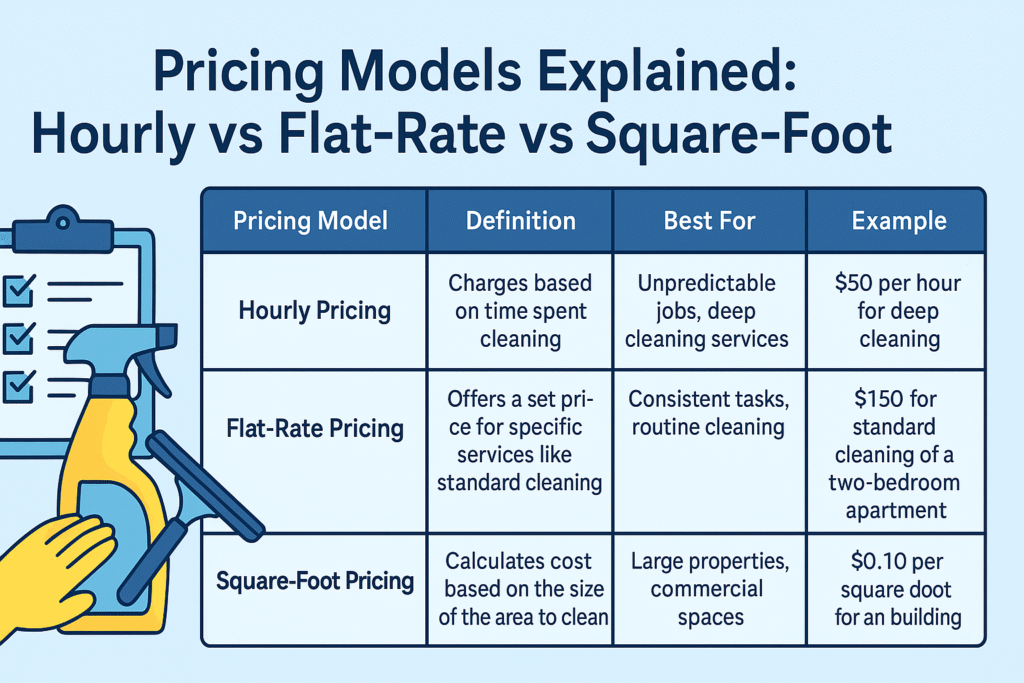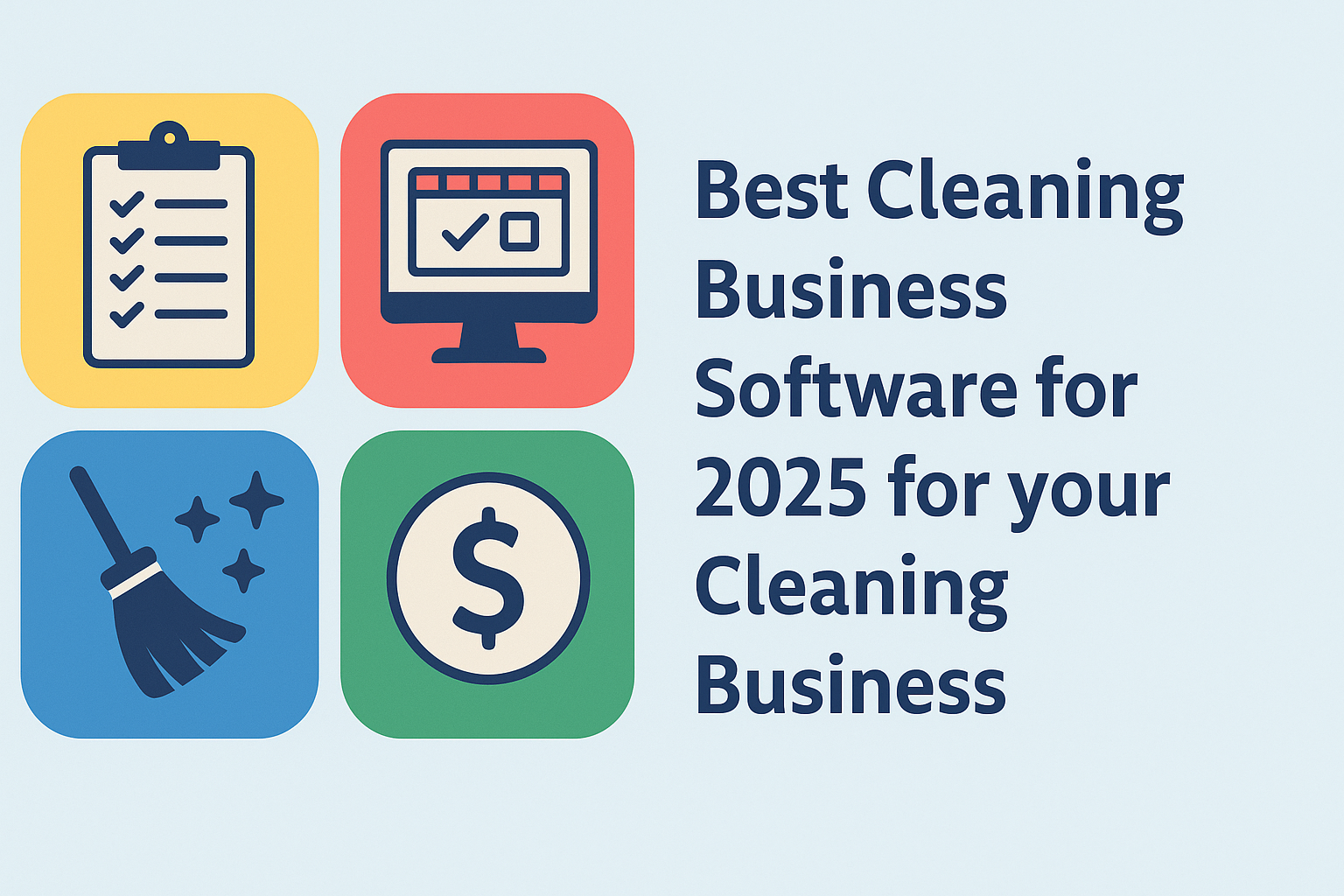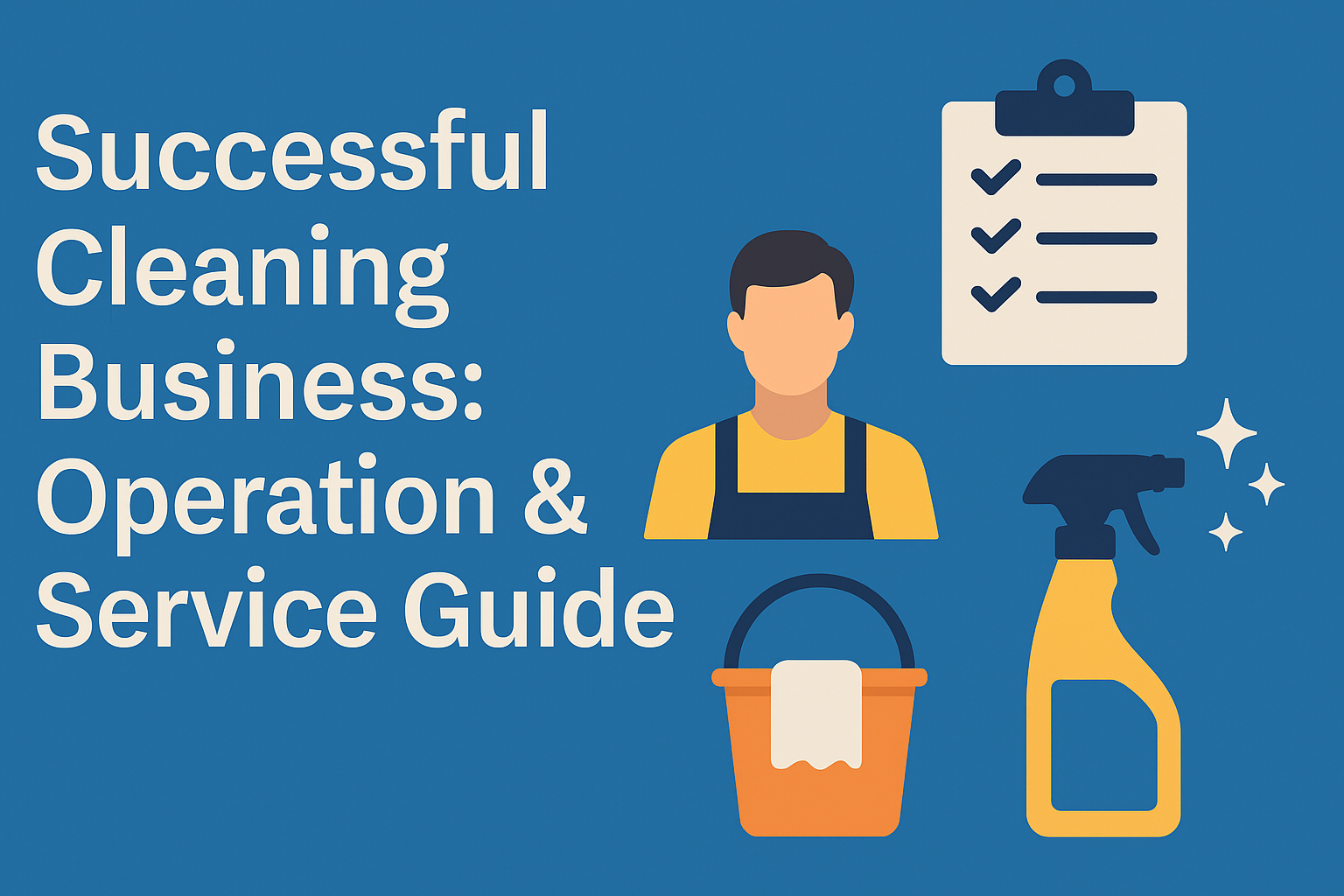Pricing Models Explained: Hourly vs Flat-Rate vs Square-Foot
Selecting the appropriate pricing model is essential for any cleaning business. The cleaning industry offers various pricing models, each with unique advantages and disadvantages. Whether you opt for hourly pricing, flat-rate pricing, or a per square foot calculation, your pricing strategy will directly impact your profitability and customer satisfaction. Understanding the nuances of each pricing structure empowers cleaning companies to price their services effectively.
Introduction to Pricing Models in the Cleaning Industry
Overview of Pricing Strategies
Pricing strategies in the cleaning industry are diverse. Options like hourly pricing offer flexibility and transparency. Alternatively, pricing based on square footage may be suitable for larger spaces.
It’s vital to carefully consider these strategies when determining how to price your services.
Importance of Choosing the Right Pricing Model
The significance of selecting the right pricing model cannot be overstated for any service business. Your chosen pricing strategy impacts profitability, competitiveness, and client satisfaction. Overpricing can deter potential customers, while underpricing can compromise your financial stability. By understanding the strengths and weaknesses of different pricing approaches, you can price your services in a manner that attracts clients while ensuring your business remains viable.
Previous Article on Valuation Multiples
Before diving deeper into various pricing models, it’s beneficial to understand the overall value of a cleaning business. If you’re interested in learning more about valuation multiples and how they impact the worth of your company, check out our previous article: Cleaning Business Valuation: Value and Multiple Explained. This will give you additional context on how pricing influences your company’s bottom line and overall valuation.
Hourly Pricing Model
Definition and Overview
Hourly pricing is a pricing model where cleaning companies charge a flat hourly rate for their cleaning services. This pricing structure is based on the amount of time it takes to complete a cleaning.
| Factor | Impact on Hourly Rate |
|---|---|
| Type of cleaning service | Can cause the hourly rate to vary |
| Experience of the cleaning staff | Can cause the hourly rate to vary |
| Location of the business | Can cause the hourly rate to vary |
Many home service businesses find this approach to be transparent as the customer understand how much they’re paying per hour.
Pros of Hourly Pricing
One significant advantage of hourly pricing is its flexibility. It’s particularly well-suited for jobs where the time required is unpredictable, such as deep cleaning or projects involving unusual clutter. Cleaning companies using this pricing strategy can accurately account for the actual time spent, ensuring fair compensation. Furthermore, customers appreciate the transparency; they know exactly how much they are paying for each hour of cleaning service. This model also accommodates add-on services like interior design changes or specialized services more effectively.
Cons of Hourly Pricing
However, hourly pricing also has drawbacks. It can be challenging to accurately estimate the total cost upfront, which may deter some customers. Clients may become anxious about the meter running and potentially question the efficiency of the cleaning staff. Additionally, if the cleaning team is slower than average, the business risks overcharging, leading to dissatisfaction. The pricing strategy also requires diligent tracking of time, adding an administrative burden to the cleaning business. You may have difficulty communicating to customers how much you will.
Real-World Example of Hourly Pricing
Consider a cleaning business that offers deep cleaning services. They might charge a flat $50 per hour. If a deep clean takes 4 hours, the total cost would be $200. This pricing model works well because the time required for a deep clean can vary greatly depending on the condition of the property. The cleaning companies should also carefully assess the market rate in order to effectively price your services.
Flat-Rate Pricing Model
Definition and Overview
Flat rate pricing, also known as fixed price pricing, is a pricing model where cleaning companies offer a set price for a specific cleaning service, regardless of the time it takes to complete. Unlike hourly pricing, customers know exactly how much they are paying upfront. This pricing structure is popular for standard cleaning tasks where the scope of work is relatively consistent. The cleaning business benefits from predictable revenue, and customers appreciate the transparency and ease of budgeting. Many home service businesses prefer the straightforwardness of this approach.
Pros of Flat-Rate Pricing
One of the primary advantages of flat rate pricing is its simplicity. Customers appreciate the predictability of know exactly how much they are paying, making it easier to budget. Cleaning companies can streamline their billing process, reducing administrative overhead. This pricing strategy can also enhance customer satisfaction because there are no surprises at the end of the cleaning service. Furthermore, it incentivizes efficiency; the faster the cleaning team completes the job, the higher the effective hourly rate becomes.
Cons of Flat-Rate Pricing
Despite its advantages, flat rate pricing has limitations. It can be challenging to accurately price your services if the scope of work varies significantly from one client to another. If a job takes longer than anticipated, the cleaning business risks losing money. Additionally, this pricing model may not be suitable for deep cleaning or other specialized services where the time required is highly variable. Customers may also feel shortchanged if the cleaning team finishes the job quickly, even if the quality is excellent.
Real-World Example of Flat-Rate Pricing
A cleaning business might offer a flat fee of $150 for a standard cleaning of a two-bedroom apartment. This pricing includes dusting, vacuuming, mopping, and bathroom cleaning. Regardless of whether it takes the cleaning team two hours or three, the customer pays $150. This pricing model is attractive to customers who want budget certainty. To effectively price your services, a guide to pricing in your local market rate is vital.
Square-Foot Pricing Model
Definition and Overview
Pricing based on square footage involves calculating the cost of cleaning services based on the size of the area being cleaned. The cleaning companies determine a per square foot rate and then multiply that rate by the total square footage of the space. This pricing model is commonly used for larger properties, such as offices, retail spaces, and warehouses. While it offers a structured approach, accurately measuring square footage is critical for fair and consistent billing.
Pros of Square-Foot Pricing
One of the key benefits of pricing based on square footage is its scalability. It provides a consistent way to price your services for properties of different sizes. This pricing strategy is especially useful for commercial cleaning contracts, where the square footage is well-defined. Cleaning companies can easily adjust their pricing as the size of the space changes. Additionally, it simplifies the estimation process, as the square footage is an objective measure.
Cons of Square-Foot Pricing
However, pricing based on square footage may not account for the level of dirt or clutter in a space. A smaller, heavily cluttered area may require more time and effort to clean than a larger, relatively tidy space. This pricing model can also be less transparent to customers, who may not readily understand the connection between square footage and the final cost. Therefore, it’s essential to communicate clearly how the per square foot rate is determined and what services like are included.
Real-World Example of Square-Foot Pricing
A cleaning business that specializes in commercial cleaning services might charge a flat $0.10 per square foot. For an office building with 10,000 square footage, the total cleaning cost would be $1,000. This pricing allows the business to scale its pricing proportionally to the size of the space. However, the company should also consider other factors, such as the frequency of cleaning and the specific services like required, to ensure accurate pricing.
Comparative Analysis of Pricing Models
Comparative Table: Hourly vs Flat-Rate vs Square-Foot
To provide a clear understanding, here’s a comparative table outlining the key differences between hourly pricing, flat rate pricing, and pricing based on square footage. This table is designed to help cleaning companies assess which pricing model best suits their needs and the needs of their clients. Understanding the nuances of each pricing structure can lead to more effective and profitable business operations. Remember to consider the market rate and your operational costs when setting your pricing.
There are different pricing models for cleaning services, each with its own characteristics. Hourly pricing involves charges based on the time spent cleaning, which can be ideal for unpredictable jobs like deep cleaning services. Flat-rate pricing, on the other hand, offers a set price for specific services like standard cleaning and is best for consistent tasks and routine cleaning. Finally, square-foot pricing calculates cost based on the size of the area to clean, making it suitable for large properties and commercial spaces.
| Pricing Model | Definition | Best For | Example |
|---|---|---|---|
| Hourly Pricing | Charges based on time spent cleaning | Unpredictable jobs, deep cleaning services | $50 per hour for deep cleaning |
| Flat-Rate Pricing | Offers a set price for specific services like standard cleaning | Consistent tasks, routine cleaning | $150 for standard cleaning of a two-bedroom apartment |
| Square-Foot Pricing | Calculates cost based on the size of the area to clean | Large properties, commercial spaces | $0.10 per square foot for an office building |
Key Takeaways from the Comparison
The comparison reveals that each pricing model serves distinct purposes. Hourly pricing is ideal for services like deep cleaning where time estimates are challenging. Flat rate pricing is best suited for routine tasks where the scope is predictable, offering customers the comfort of know exactly how much they are paying. Pricing based on square footage excels in commercial settings where scalability and consistency are paramount. The choice depends on the cleaning companies capabilities, the types of services like offered, and the target customer base. A guide to pricing is vital in order to understand the market rate and to effectively price your services.
Conclusion
Summary of Pricing Models
In summary, selecting the right pricing model is a critical decision for any cleaning business. Hourly pricing offers flexibility and transparency, making it suitable for jobs with variable time requirements. Flat rate pricing provides simplicity and predictability, appealing to customers who appreciate fixed costs. Pricing based on square footage is scalable and consistent, making it ideal for larger commercial spaces. Each pricing strategy has its strengths and weaknesses, and the best choice depends on the specific needs of the business and its clients.
Final Recommendations for Cleaning Service Pricing
Ultimately, cleaning companies should carefully evaluate their operational costs, the types of services like offered, and the preferences of their target market. Consider conducting a market rate analysis to understand what competitors are charging and adjust your pricing accordingly. Regularly review and refine your pricing strategy to ensure it remains competitive and profitable. Whether you opt for hourly pricing, flat rate pricing, or pricing based on square footage, effective communication with your customers is key to building trust and ensuring satisfaction. A well-thought-out pricing strategy is fundamental to the success of any service business and will help the cleaning companies effectively price your services.







